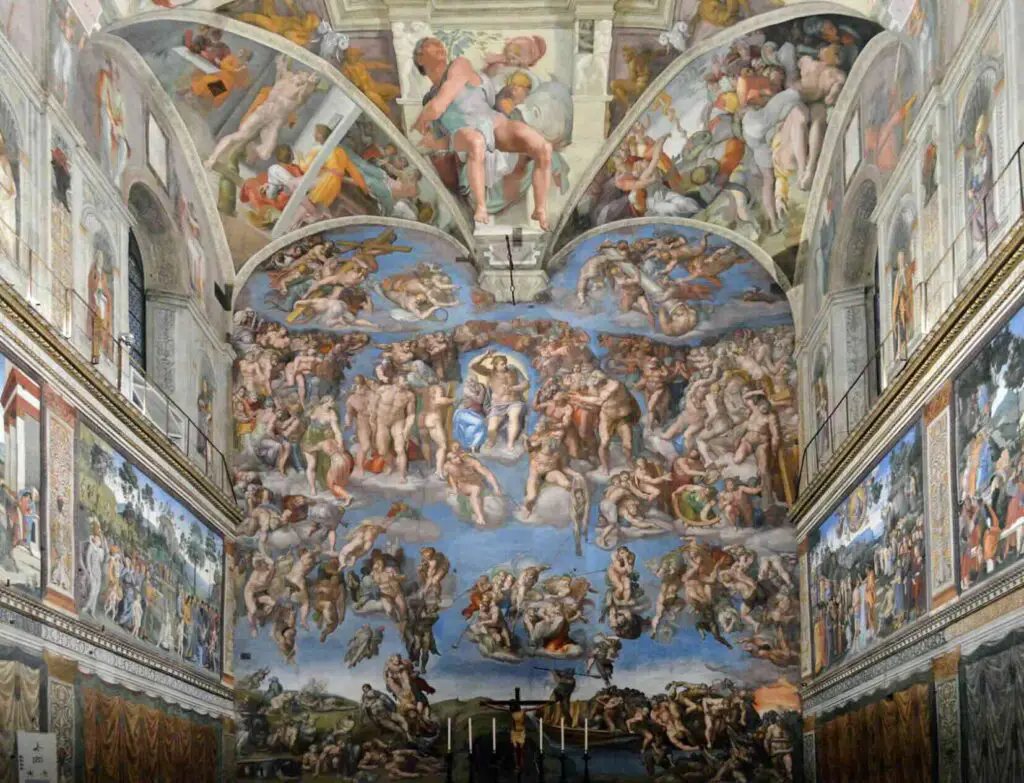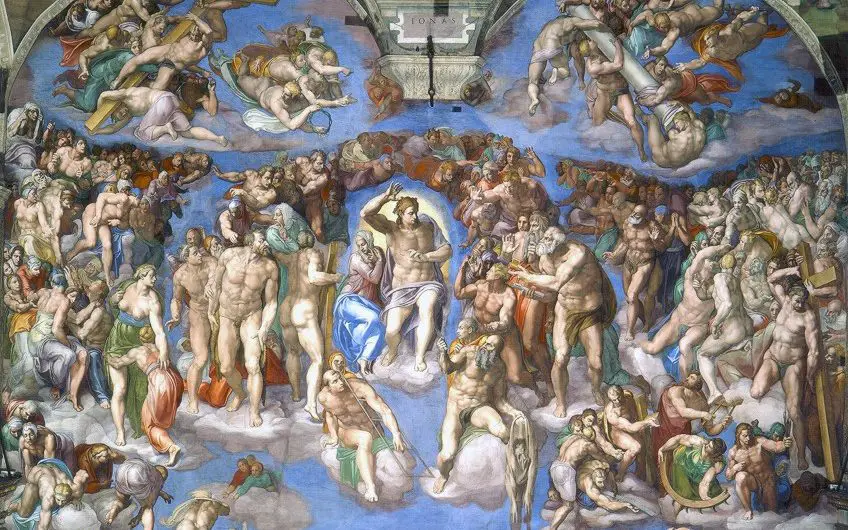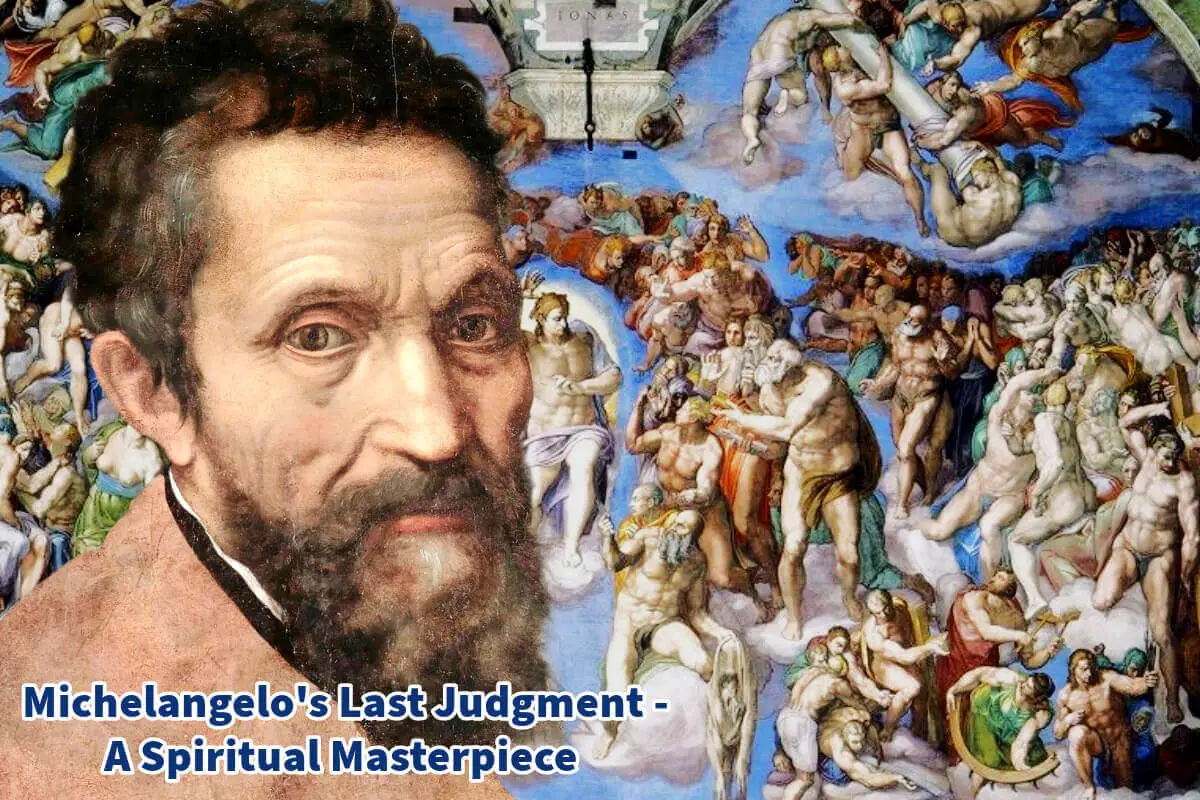Michelangelo’s The Last Judgment is a seminal masterpiece, regarded as one of the artist’s most significant creations.
Located on the walls of the Sistine Chapel, this iconic piece is highly esteemed in the art world, although it was not without its share of controversy upon completion. Keep reading to delve deeper into this monumental work of art.
Table of Contents
- Michelangelo’s The Last Judgment: A Masterpiece Of Spiritual And Artistic Grandeur
- A Visual Tour de Force
- Michelangelo’s Personal Imprint
- The Triumph Of Christ
- The Controversy Surrounding The Last Judgement
- Related Questions
Michelangelo’s The Last Judgment: A Masterpiece Of Spiritual And Artistic Grandeur
The Sistine Chapel in the Vatican is an unforgettable testimony to the inexhaustible possibilities of human creativity. One of its most iconic elements is Michelangelo’s “The Last Judgment,” a monumental fresco painted on the chapel’s altar wall.

Commissioned by Pope Paul III in 1534, the artwork captures the pivotal moment of the final judgment in Christian eschatology, serving as a theological, artistic, and cultural touchstone for future generations.
Context: A Church In Crisis
To appreciate the significance of “The Last Judgment,” it is essential to grasp the historical context surrounding its creation. Pope Paul III, who assumed the papacy in 1534, inherited a Catholic Church in turmoil.

The Sack of Rome (1527) was fresh in collective memory, and the Protestant Reformation was rapidly undermining the authority of the Church. Eager to address these issues and reestablish the Church’s priority,
Paul III turned to art as a powerful medium to convey its message. The Sistine Chapel already showcased a decorative program that encapsulated the biblical narrative. Michelangelo’s edition of “The Last Judgment” would complete this cosmic story, providing an unyielding visual statement of the Church’s doctrines and authority.
A Visual Tour de Force
Michelangelo’s “The Last Judgment” is nothing short of overwhelming. Over 300 figures—each painstakingly sculpted in paint—occupy the monumental canvas. The composition lacks any painted borders, thus extending infinitely beyond the viewer’s field of vision.
This aspect of boundlessness amplifies the immediacy of the scene: the judgment is yet to come, and when it does, each viewer will be a part of it.

Structure And Symbolism
Despite its complex density, “The Last Judgment” is meticulously organized. The arrangement of figures into tiers and quadrants facilitates the viewer’s comprehension.
The fresco’s composition rises to the left and descends to the right, echoing the scales used in many earlier depictions of the Last Judgment.
At the center stands Christ, a muscular, compelling figure whose movement triggers the division of the blessed and the damned. His positioning serves as the fulcrum around which the entire tableau revolves.
A Shift In Virgin Mary’s Pose
Notably, the Virgin Mary, positioned under Christ’s raised arm, assumes a pose of surrender rather than pleading, as evidenced in Michelangelo’s preliminary drawings. This change is symbolic: the time for mediation has elapsed; judgment is irreversible.
The Role Of Angels
Directly below Christ, wingless angels sound the trumpets to summon the dead. The angel holding the Book of the damned angles it downwards, underscoring the justice behind their eternal damnation.
The Elect And The Damned
The painting divides the fate of human souls into the realms of heaven and hell. In line with Christian doctrine, the elect ascends to heaven, while the damned are cast into hell.
This division is not merely a binary but a complex, multi-layered narrative. The elect encircles Christ, holding instruments symbolizing their martyrdom—St. Andrew with his X-shaped cross, St. Lawrence with his gridiron, and St. Sebastian with a bundle of arrows, among others.
Michelangelo’s Personal Imprint
One of the most striking features is Michelangelo’s self-insertion into the fresco as the face on the flayed skin held by St. Bartholomew. This is a poignant metaphor for the artist’s vulnerability, caught between the realms of the divine and the damned.
Additionally, it evokes the classical myth of Marsyas and Apollo, providing an intellectual delight for educated viewers familiar with such literary references.
The Triumph Of Christ
While Michelangelo’s work may inspire dread, its primary focus is the triumph of Christ. The heavenly realm dominates the fresco, replete with saints and angels. The boundary of the picture plane dissolves as the elect extends into the painting’s depth, underscoring the boundless majesty of the divine.
A Masterful Fusion Of Art And Theology
“The Last Judgment” is a religious painting and a complex tapestry of theology, personal expression, and artistic innovation. Michelangelo employs visual and literary metaphors to enrich his depiction, ensuring it would resonate on multiple levels for diverse audiences.
“The Last Judgment” is a testament to Michelangelo’s audacity and genius. Its intricate composition, rich symbolism, and spiritual depth make it a cornerstone of Western art and Christian doctrine.
The Controversy Surrounding The Last Judgement
The “Last Judgment” painting in the Sistine Chapel, one of Michelangelo’s most famous works, has been controversial since its completion. Commissioned by Pope Clement VII and later completed under Pope Paul III, the fresco covers the entire altar wall of the Sistine Chapel. It depicts the second coming of Christ and the final judgment of souls.
However, the painting’s content drew criticism from various quarters within the Catholic Church. The figures’ nudity, in particular, stirred controversy, with many feeling that such explicit imagery was inappropriate for a sacred space like the Pope’s private chapel. Biagio da Cesena, the Papal Master of Ceremonies at the time, went so far as to call the fresco “outrageous,” stating it was more suited for public baths or taverns than a place of worship.
This dispute over the appropriateness of the “Last Judgment” epitomizes the tension between artistic expression and religious decorum. Despite the initial controversy, the painting remains one of history’s most studied and admired artworks, illustrating the complexities of art, religion, and cultural norms.
More than just a religious fresco, The Last Judgement is a vivid narrative that captures the complexities of faith, the uncertainties of judgment, and the eternal struggles between good and evil, grace and damnation. In this masterwork, Michelangelo offers a sublime synthesis of art and spirituality that continues to provoke, inspire, and awe, even nearly five centuries after its completion.
Anita Louise Art is dedicated to art education, great artists, and inspiring others to find and create their art. We love art that uplifts and inspires. #ArtToMakeYouSmile! #ArtToMakeYouHappy!
If you are interested to see any of my art, you can find out more by clicking here. If you are interested in what inspires me and my paintings, you can discover more by clicking here.
We have a free newsletter and would love you to be part of our community; you can subscribe to the newsletter by clicking here. If you have any questions, I would be happy to talk to you at any time. You can reach me, Anita, by clicking here.
Subscribe to our Anita Louise Art YouTube Channel filled with great videos and information by clicking here.
Related Questions
Did Michelangelo And Leonardo Know Each Other?
Michelangelo and Leonardo da Vinci knew each other but were considered bitter rivals. Leonardo da Vinci and Michelangelo knew each other, but they did like each other. They were both asked to do a commission on the Council Hall of the Palazzo Vecchio and were supposed to work side-by-side; the project was never completed.
By clicking here, you can learn more by reading Did Michelangelo And Leonardo Know Each Other?.
What Was The Focus Of Renaissance Art?
The focus of Renaissance art was on the classics of Greek and Rome, humanist philosophy, and the study of the human figure. Realism was also an essential part of renaissance art. The great artists of the Renaissance also became great anatomists and studied human beings.
By clicking here, you can learn more by reading What Was The Focus Of Renaissance Art?.
Michelangelo’s Sistine Chapel And His Payment
Michelangelo was paid 3200 gold ducats for his work on the ceiling of the Sistine Chapel, which would have been a very lucrative commission. We know that he stopped work on the ceiling for a while due to his not being paid by the Vatican. Michelangelo liked to give the impression that he was a very poor artist, but records have shown that he died an extremely wealthy man.
By clicking here, you can learn more by reading Michelangelo’s Sistine Chapel And His Payment.


